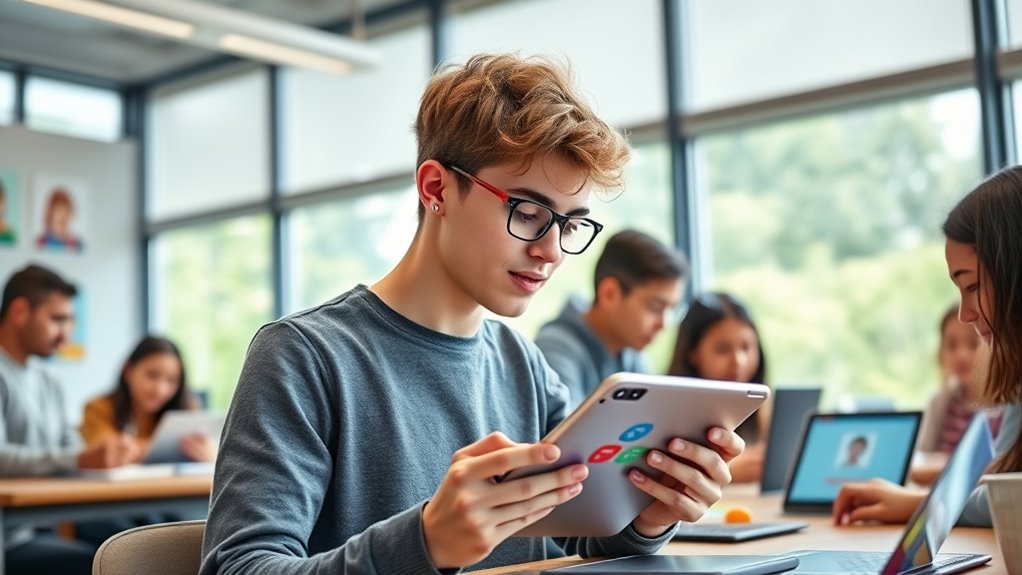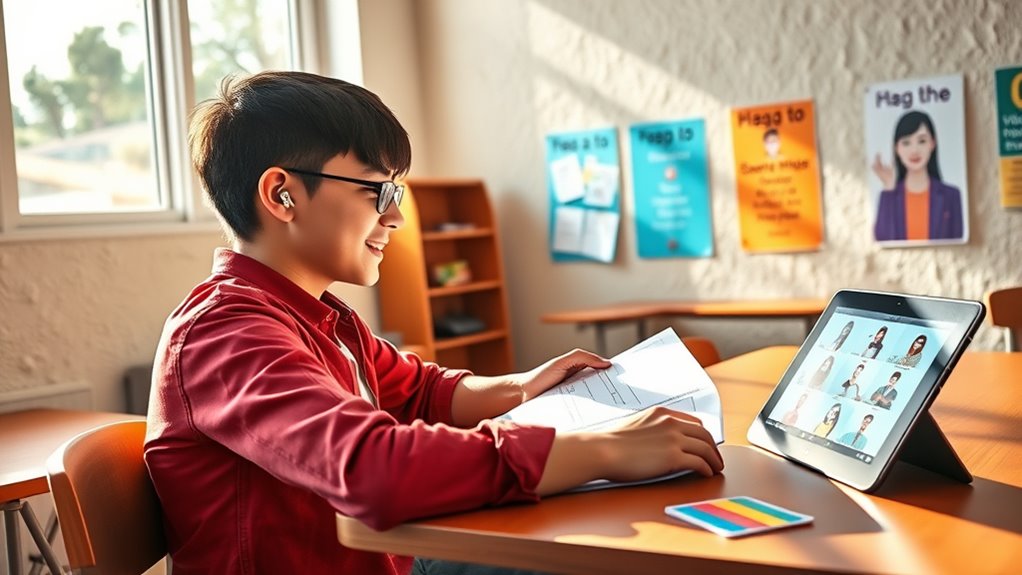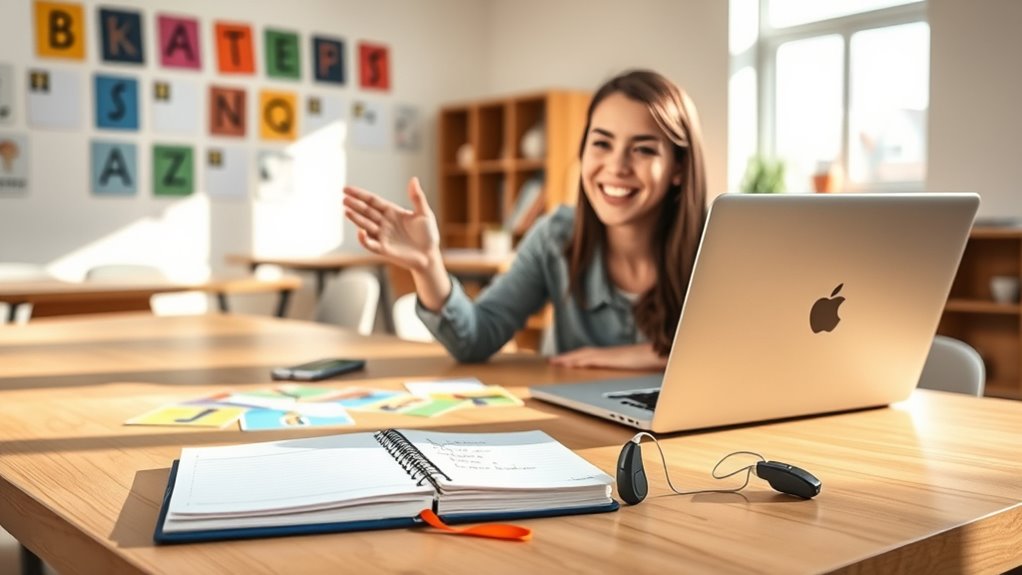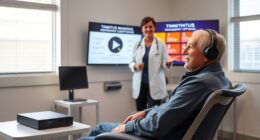Learning a new language after hearing loss is both possible and enjoyable. With innovative strategies like sign language, multisensory approaches, and helpful technology, you can overcome challenges and make progress at your own pace. Supportive communities, cultural events, and visual tools boost motivation and make learning fun. Many have succeeded using these methods, so your journey can be rewarding too. Keep exploring—there’s much more to discover about making language learning accessible and exciting for you.
Key Takeaways
- Learning a new language is highly feasible with visual, tactile, and multisensory strategies tailored for hearing loss.
- Technology tools like speech-to-text, sign language apps, and visual aids make language acquisition engaging and accessible.
- Community activities, cultural events, and language exchange meetups enhance fun, motivation, and real-life practice.
- Sign language, visual cues, and assistive devices support effective communication and reinforce learning enjoyment.
- Persistence, creative methods, and support networks turn language learning into an achievable and enjoyable experience.
Understanding the Challenges and Opportunities in Language Learning With Hearing Loss

Hearing loss can considerably impact your ability to learn a new language, but it also presents unique opportunities for growth. You might find that traditional listening-based methods are less effective, encouraging you to explore alternative strategies like sign language and multisensory learning. Sign language provides a visual and tactile way to communicate, making language acquisition more accessible and engaging. Embracing multisensory learning involves combining visual, tactile, and kinesthetic approaches, which can enhance your understanding and retention. These methods turn potential obstacles into strengths, allowing you to develop language skills through different senses. Additionally, cultivating creative practice in your learning process can foster new methods and innovative ways to overcome challenges. By focusing on these opportunities, you can create a personalized learning experience that respects your hearing abilities while opening new pathways for language mastery.
Technological Tools That Make Language Acquisition More Accessible

Technological tools have revolutionized language learning by making it more accessible for individuals with hearing loss. Speech recognition apps allow you to practice pronunciation and receive real-time feedback, bridging gaps in understanding. Language translation tools help you communicate across languages effortlessly, breaking down barriers. These innovations enable you to engage with new languages through visual cues and text-based interactions, reducing reliance on auditory input. Additionally, the rise of global entertainment industry influence has increased the availability of diverse multimedia resources, further supporting language acquisition for learners with hearing challenges.
Effective Strategies for Learning a Language After Hearing Loss

To learn a new language effectively after hearing loss, you should focus on visual learning techniques that enhance understanding. Using assistive devices can also support your progress by improving communication and access to language input. Combining these strategies helps you overcome challenges and accelerates your language acquisition. Incorporating self-guided learning tools such as videos, apps, and flashcards can further reinforce your skills and promote independent practice.
Visual Learning Techniques
Since auditory cues are limited, visual learning techniques become essential for acquiring a new language after hearing loss. You can enhance understanding through gesture-based learning, which helps you connect movements with words or phrases. Facial expression analysis allows you to interpret emotions and context, enriching your comprehension. Incorporate these strategies:
- Observe and mimic gestures to reinforce vocabulary
- Pay attention to facial expressions to grasp tone and intent
- Use visual aids like charts or flashcards for vocabulary building
- Watch videos with subtitles to connect words with visual cues
- Understanding visual cues’ importance can significantly improve your language acquisition process, especially when auditory information is limited.
These techniques engage your visual senses, making learning more effective and enjoyable. They help you decode meaning beyond sound, supporting your language acquisition journey with clarity and confidence.
Use of Assistive Devices
Using assistive devices can considerably enhance your ability to learn a new language after hearing loss by providing clear, accessible auditory input. Devices like hearing aids and cochlear implants improve sound clarity, making it easier to pick up pronunciation and intonation. Speech-to-text technology is especially helpful, as it transcribes spoken words in real-time, allowing you to read along and reinforce understanding. These tools reduce frustration and help you focus on learning vocabulary and grammar without missing key information. Incorporating assistive devices into your language practice makes the experience more engaging and effective. With consistent use, you’ll build confidence in your listening skills and accelerate your language acquisition, all while overcoming auditory challenges. Effective language learning tools can further support your progress by offering tailored exercises and feedback.
Building Support Networks and Community Engagement

Building support networks is essential as you learn a new language after hearing loss. You can connect with local groups, join online communities, and participate in cultural events to stay motivated. These activities help you practice, stay engaged, and find encouragement along your journey. Incorporating elements of home decoration inspiration can also create a welcoming environment that fosters comfort and motivation during your language learning process.
Connecting With Local Groups
Connecting with local groups can make a significant difference in your journey to learn a new language after hearing loss. Joining local language clubs gives you a supportive space to practice communication and build confidence. Participating in cultural immersion activities helps you understand context, idioms, and customs, making learning more engaging. These groups often include people with similar experiences, so you can share tips and encouragement. Attending language exchanges or meetups allows real-time practice, boosting your skills. Plus, engaging locally helps you stay motivated and connected to your community. Whether through local classes, events, or informal gatherings, these connections enhance both your language skills and sense of belonging. Building these networks creates a foundation for ongoing learning and social support. Incorporating effective learning tools like eye patches into your routine can also help reduce fatigue and keep you focused during practice.
Online Language Communities
Have you considered how online language communities can strengthen your support network after hearing loss? Joining these communities offers opportunities for language exchange with native speakers and fellow learners worldwide. Through virtual classrooms, you can practice speaking and listening in a supportive environment, often with accommodations like captions or transcripts to enhance understanding. Participating in online forums or social media groups allows you to share progress, ask questions, and find encouragement from others facing similar challenges. These digital spaces foster consistent engagement and help build a sense of belonging, even if local options are limited. Knowledge of store hours can help you plan your online activities to fit into your schedule, ensuring you stay connected and motivated. By integrating online language communities into your learning plan, you create a flexible, accessible support network that boosts confidence and keeps you motivated on your language journey.
Participating in Cultural Events
Participating in cultural events offers a meaningful way to expand your support network and engage actively with your new language community. These events foster cultural immersion, helping you understand traditions and context that deepen language learning. Attending festivals, art exhibits, or performances allows you to practice language skills in real-life situations. You can also join language exchange meetups during these events, creating opportunities for conversation and feedback. Engaging with native speakers and fellow learners builds confidence and emotional support. Plus, shared experiences strengthen connections with the community, making learning more enjoyable. Whether it’s a dance workshop or culinary festival, immersing yourself in cultural events enriches your journey, making language acquisition both fun and socially rewarding.
Success Stories: Inspiration From Learners With Hearing Impairments

Many learners with hearing impairments have achieved remarkable success in mastering new languages, proving that hearing loss doesn’t have to be a barrier to communication. For example, some use sign language as a foundation, combining it with speech therapy techniques to enhance pronunciation and comprehension. Others have learned to read lips or utilize visual cues, making language learning more accessible. These success stories show that persistence and the right resources can lead to great achievements. Hearing-impaired learners often find innovative methods that work for them, demonstrating that language acquisition is possible regardless of hearing ability. Their journeys inspire others to pursue language learning, emphasizing that determination, combined with support like sign language and speech therapy, can turn challenges into triumphs. Additionally, motivational quotes about fatherhood remind us of the importance of encouragement and support in overcoming obstacles.
Tips for Staying Motivated and Overcoming Obstacles

Staying motivated while learning a new language with hearing loss can be challenging, but focusing on your progress and setting achievable goals keeps you moving forward. To maintain motivation, try different motivational techniques like rewarding yourself for milestones or tracking improvements. When faced with obstacles, practice obstacle management by breaking tasks into smaller steps or seeking support from others. Remember, setbacks are normal—reframe them as opportunities to learn. Keep your learning engaging by using visual aids or signing along with content. Regularly remind yourself why you started and celebrate small wins. Maintaining this mindset helps you stay committed, even when progress feels slow. Additionally, understanding the importance of specialized tuning methods can inspire confidence in adapting to new learning strategies. With perseverance and strategic techniques, you’ll find joy in your language journey despite challenges.
Frequently Asked Questions
Can Sign Language Be Integrated Into Spoken Language Learning?
You can definitely integrate sign language into spoken language learning through sign language immersion and bilingual education. This approach helps you develop both skills simultaneously, making language learning more engaging and accessible. By combining signs with spoken words, you reinforce understanding and memory. This method fosters a richer, more inclusive learning experience, allowing you to communicate effectively in diverse situations and enhancing your overall language proficiency.
Are There Specific Age Groups More Successful in Language Acquisition Post-Hearing Loss?
You might think age is just a number, but when it comes to language learning post-hearing loss, it’s a game-changer! Younger folks often breeze through due to fewer age-related challenges and higher motivation factors, making language acquisition seem almost effortless. Older adults face steeper hurdles, but with determination and tailored methods, they can still succeed. Your age influences your journey, but passion and persistence make all the difference!
How Do Cultural Factors Influence Language Learning Experiences for Hearing-Impaired Individuals?
Cultural factors greatly influence your language learning journey, especially regarding cultural identity and social acceptance. When you feel connected to a culture, you’re more motivated to learn its language, enhancing your confidence and engagement. Social acceptance also plays a role; inclusive environments encourage participation and reduce anxiety. Embracing your cultural identity helps you overcome barriers, making the process more meaningful and enjoyable as you integrate language skills with your sense of self.
What Role Does Lip-Reading Play in Learning New Languages?
Think of lip-reading as a bridge connecting you to a new language. It relies on visual cues and speech patterns, allowing you to understand spoken words when hearing isn’t enough. For example, I met someone who mastered lip-reading, enabling her to follow conversations in a foreign language. It’s an active skill that enhances language learning, helping you decode sounds through sight, making communication more accessible and boosting your confidence in new linguistic environments.
Are There Specialized Language Programs Designed for Learners With Hearing Impairments?
You’ll find that some specialized language programs for learners with hearing impairments include assistive technology like visual aids, captioning, and speech-to-text tools. These programs often emphasize peer support, creating a community where you can practice and improve your skills comfortably. This combination helps you overcome challenges, making language learning more accessible and engaging, while also fostering confidence through shared experiences and tailored resources.
Conclusion
Learning a new language after hearing loss is not only possible but also rewarding. With the right tools and strategies, you can overcome challenges and enjoy the journey. Did you know that over 90% of adults with hearing impairments successfully learn new skills through specialized resources? Keep exploring, stay motivated, and connect with others. Your dedication can turn language learning into a fun and empowering experience, proving that hearing loss doesn’t have to hold you back.











